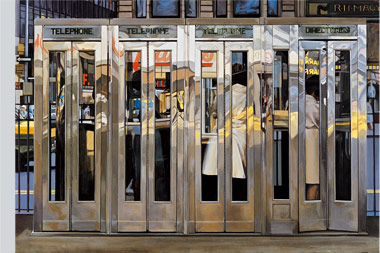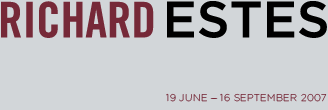
Telephone Booths, 1967
Acrylic on masonite. 122 x 175,3 cm
Museo Thyssen-Bornemisza, Madrid
Acrylic on masonite. 122 x 175,3 cm
Museo Thyssen-Bornemisza, Madrid




Richard Estes (born Kewanee, Illinois, 1932) is known as one of
the founders of Photorealism, a movement in painting which
arose in the US in the late 1960s and early 1970s. Estes, however,
does not identify himself with this trend and prefers simply
to be considered a painter in the traditional sense of the term.
His painting goes beyond mere photographic reference and Estes
has never limited himself to copying a photograph. Rather,
he constructs an authentic pictorial composition using various
photographic images as auxiliary material but also making use
of drawing, perspective and the study of light.
Although he has painted rural landscapes, Richard Estes is primarily a painter of urban views, including scenes of Chicago, Paris, Venice, San Francisco, Prague, Barcelona, London, Cordoba and Florence. It is New York, however, to which he has devoted most time and attention. Manhattan is the matrix of all the cities that Estes has painted, just as Central Park is the model for all his rural landscapes and the Bay of New York the origins of all his views with water, from the Grand Canal to the Sea of Marmara. Estes' city views include a wealth of signs that indicate a particular time and place: the models of the cars, the publicity awnings, the shop windows, even the clothes worn by passers-by. Beyond this ephemeral element, however, the city-every city- unfolds in Estes' work like a crystalline structure of infinite facets, both identical and always in the process of change.
Estes' Realism is not the passive reproduction of what we see but rather a questioning of the visible, hence the almost obsessive use of reflections. Since 1967 when the artist painted the Flatiron building reflected in the bodywork of a car, reflections appear throughout Estes' work: on cars and buses, in window panes and shop windows and in water. These reflective surfaces are not smooth and uniform but are filled with waves and eddies that alter and distort what is reflected in them. As they unfold on these surfaces, the real objects become fantastical and unrecognisable monsters, like the female nudes in André Kertesz's photographs. On occasions our only perception of the real world in Estes' painting is via a reflection through which the world appears inverted, fragmented and distorted.
At other times the world splits into two. A glass wall traverses the pictorial space as it recedes into depth and divides it into two halves: the inside and the outside of a bus or a shop window. For much of his career Estes has focused on exploring the ambiguity of the pane of glass that sometimes reflects and at other times both reflects and functions as a transparent surface, confusing everything within the painting. Shop windows are magical places in which reflections and transparent elements co-exist and in which exterior and interior come together. Estes' approach brings to mind Monet in his late scenes of garden ponds: reflections and reflections of reflections in which we loose our sense of the object depicted and even of up and down. Richard Estes is thus not an unthinking realist but rather a painter who complicates his vision of reality. He is a Baroque artist who takes a perverse delight in trompe-l'oeil and illusion. He is a creator of labyrinths in which the natural and the artificial, reality and appearance, are guests at a masked ball.
Although he has painted rural landscapes, Richard Estes is primarily a painter of urban views, including scenes of Chicago, Paris, Venice, San Francisco, Prague, Barcelona, London, Cordoba and Florence. It is New York, however, to which he has devoted most time and attention. Manhattan is the matrix of all the cities that Estes has painted, just as Central Park is the model for all his rural landscapes and the Bay of New York the origins of all his views with water, from the Grand Canal to the Sea of Marmara. Estes' city views include a wealth of signs that indicate a particular time and place: the models of the cars, the publicity awnings, the shop windows, even the clothes worn by passers-by. Beyond this ephemeral element, however, the city-every city- unfolds in Estes' work like a crystalline structure of infinite facets, both identical and always in the process of change.
Estes' Realism is not the passive reproduction of what we see but rather a questioning of the visible, hence the almost obsessive use of reflections. Since 1967 when the artist painted the Flatiron building reflected in the bodywork of a car, reflections appear throughout Estes' work: on cars and buses, in window panes and shop windows and in water. These reflective surfaces are not smooth and uniform but are filled with waves and eddies that alter and distort what is reflected in them. As they unfold on these surfaces, the real objects become fantastical and unrecognisable monsters, like the female nudes in André Kertesz's photographs. On occasions our only perception of the real world in Estes' painting is via a reflection through which the world appears inverted, fragmented and distorted.
At other times the world splits into two. A glass wall traverses the pictorial space as it recedes into depth and divides it into two halves: the inside and the outside of a bus or a shop window. For much of his career Estes has focused on exploring the ambiguity of the pane of glass that sometimes reflects and at other times both reflects and functions as a transparent surface, confusing everything within the painting. Shop windows are magical places in which reflections and transparent elements co-exist and in which exterior and interior come together. Estes' approach brings to mind Monet in his late scenes of garden ponds: reflections and reflections of reflections in which we loose our sense of the object depicted and even of up and down. Richard Estes is thus not an unthinking realist but rather a painter who complicates his vision of reality. He is a Baroque artist who takes a perverse delight in trompe-l'oeil and illusion. He is a creator of labyrinths in which the natural and the artificial, reality and appearance, are guests at a masked ball.
